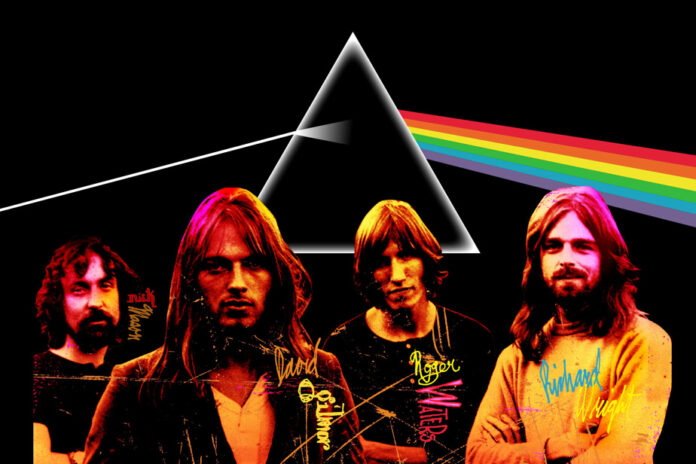Released in March 1973, the album The Dark Side of the Moon marks a turning point in Pink Floyd’s work. The group’s psychedelic influences remain, but the album no longer contains lengthy instrumental explorations. The time is no longer for the search for sound textures, but for the need to be up to the task. The group succeeds in sublimating the avant-garde technological innovations of the time in shorter and melodic songs which, despite everything, remain soaring. The effectiveness of the sounds is formidable and nothing is superfluous.
If the album begins the cycle of Roger Waters as main composer, the sublime guitar playing of David Gilmour transcends the record. Even the words become clearer and more direct.
Engineer Alan Parsons’ contribution to the album’s sound is undeniable. Parsons had studied at the Beatles’ famous Abbey Road studio. He notably recorded the Beatles’ Let It Be and Abbey Road albums. One of his last collaborations with the Beatles was at the band’s famous concert on the roof of the Apple Corps studio, which was also their last show. His work on the album earned him a Grammy nomination.
Alan Parsons was credited with the genius of recruiting backing vocalist Clare Torry. The frail Briton pushes the magnificent vocal solo heard on The Great Gig in the Sky, an anthology piece. Just like the musicians, Torry didn’t know what to do with this piece.
Clare Torrey only learned of her participation in the album when she purchased the record.
Oddly enough, Torry would only sing this song once on stage with the group, several years later. She was only paid 30 pounds sterling ($60 CAD) for this performance on the album and had to sue EMI and Pink Floyd for recognition of her copyright. His contribution was finally admitted in 2005.
Graphic designer Storm Thorgeson was friends with Syd Barrett (early lead singer of Pink Floyd) and bassist Roger Waters, whom he had known in Cambridge at secondary school. Thorgerson and Aubrey Powell founded the Hipgnosis agency which produced a legion of record covers for very popular groups like Led Zeppelin, Genesis, Styx, Yes, Black Sabbath, Paul McCartney, etc.
The only member of the band actually interested in the cover design, keyboardist Richard Wright had asked Thorgeson to design a simple, bold cover. Thorgerson was the author of several other Pink Floyd covers and his art contributed perfectly to the band’s mystique. Five concepts were proposed, but the idea of the prism where the light is split was popular. The album cover has become a classic.
Throughout the album, voices declaim short sentences. “I’m not afraid of dying…”, we can hear on The Great Gig in the Sky. These recordings are the result of a curious little game by the group. Each person who entered Abbey Road Studios was given a card with a question on it. The question could sometimes be trivial, sometimes profound, but the answer was recorded.
Technicians, roadies, wives… everyone goes through it. Even Paul McCartney, whose passages we didn’t remember. The studio doorman, Irishman Gerry O’Driscoll, gets the last quote in his solid accent: “There is no dark side of the moon, really. As a matter of fact, it’s all dark” closes the album. In fact, he added that it is the sun that makes the moon bright. A part considered too optimistic to appear on the album…
A sarcastic critique of consumerism, the song Money is the best-selling extract. The album remained on the Billboard 200 chart for 736 weeks in a row. The 45 million albums sold make it possible to reap huge revenues.
A curious irony for a band who gave singer Clare Torrey a pittance and paid sound engineer Alan Parsons £35 a week for the duration of the recording session. The cash register sound effects from the beginning of the song still resonate…















